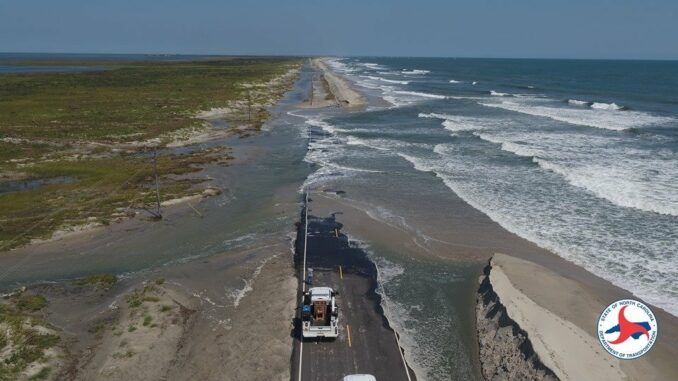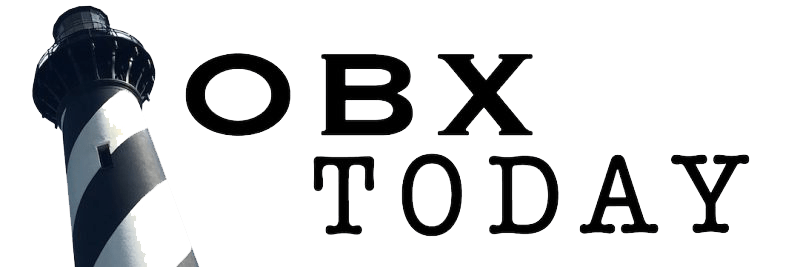
Ocracoke’s County Commissioner Tom Pahl echoes other islanders when he says he hasn’t had much time to reflect on the coming anniversary of the worst flooding in Ocracoke’s history by Hurricane Dorian on Sept. 6, 2019.
“It’s almost a case where we’ve just been so busy and there’s been so much going on between Dorian and COVID, I haven’t had time to step back,” he said in a recent interview.
The COVID-19 pandemic arrived this spring while islanders were still rebuilding their lives though looking forward to the visitor economic surge.
Stephanie O’Neal is one who hopes to keep the feelings at bay come Sept. 6.
“My fear is all of those feelings will come back,” she said taking a break from daily chores to talk with her mom, Stella, on her Creek Road porch. Stella and her husband, Carson, Stephanie’s dad, have been staying with her. The elder O’Neals’ house nearby was one of the first demolished on the island after the storm and will be rebuilt.
Stella, who was an infant during the storm of 1944, has seen a lot of hurricanes, but Dorian “was the worst one I’ve ever seen.”

Those several weeks after the storm are kind of a blur, as so many worked feverishly to deal with their homes, help neighbors or help at the Ocracoke Volunteer Fire Department, which immediately became the command center for all kinds of help and the place to get food and supplies.
“I don’t think I know how traumatized I was,” said one islander who declined to be identified. “I’m trying to stay in the present and work toward the future.”
Soon after the waters receded, the disaster aid groups and the hundreds of volunteers, in groups or as individuals, descended like ministering angels.
“I can still see peoples’ faces that came and helped,” said Darlene Styron, who coordinated the Volunteer Organizations Active in Disasters, and whose own business, the Sweet Tooth/Fig Tree Deli, was severely damaged. “I think about them every day. They love Ocracoke. We wouldn’t be as far along as we are without all of that help.”
Pahl agreed.
“For the rest of my life I’ll never forget, the way the community came together, pulled together, not just the four corners of the village but the wider community, across the sound,” he said. “It was an absolutely incredible experience to be a part of that kind of generosity and kindness.”

A year later, Ocracoke is more resilient than it was, principally because of the number of houses that have been elevated.
“The next time this happens, that many houses won’t be flooded,” Pahl said. “Our movement towards resilience is really almost limited to elevating homes, but it’s a big difference.”
Though many homes were demolished, if new homes are built on those lots, they will be raised up and thus add further resiliency.
At least 15 businesses did not reopen after Dorian with about nine of those permanently gone. At least five will open after renovations.
Pahl, who talks to a lot of people daily, says island businesses that are back up are doing remarkably well despite the second punch delivered this year by the global COVID-19 pandemic.
“People are looking for a safe place to be,” Pahl said, “and visitation is up. At the Cape Hatteras National Seashore visitation has hit an all-time high.”
Maybe COVID is to thank for that since people can’t travel abroad.
With the pandemic on top of rebuilding, businesses also have been hurting for summer help, Styron noted. After the storm a number of residents left, though no one knows how many.
Alicia Peel, administrative assistant for the Ocracoke Interfaith Relief & Recovery Team, noted that 163 homes were ruled uninhabitable and Dorian displaced an estimated 489 people.
From 60 to 135 people are still displaced, or about 20 percent of those initially displaced, she said. Peel estimates that 20 to 45 cases/families are still displaced because they may be staying with friends and families.

Thirty families were placed in travel trailers when these temporary homes got onto the island in January and 20 families remain in them.
Ruth Fordon, an island counselor who with Desiree Christa Ricker facilitates a weekly post-Dorian support group, said islanders have post-traumatic stress syndrome.
“It’s totally normal and expected when a storm comes,” she said about fears.
But Pahl also thinks the island has made progress toward emotional resilience.
“In the sense that the new norm is working toward resilience and I think that’s something that everybody’s got in their mind now,” he said. “I don’t believe anybody believes that we aren’t going to have this (kind of storm) again.”
And the OIRRT and everyone on the island will jump in to help should another disaster strike.
An island in Hurricane Alley needs to be resilient and “Ocracoke Strong,” a phrase coined after Dorian struck.
Ocracoke is much like Fordon’s garden, which was flooded and destroyed, but when spring came, a new set of plants appeared.
“Nature has come back with its own response,” she said.
So has Ocracoke.

